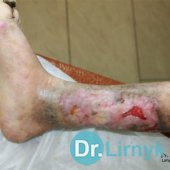Trophic ulcer
Trophic ulcers have been known for thousands of years. They are described in the Bible. Ulcers were found in mummies in Egyptian tombs. For centuries people have been trying to find remedies and means to treat ulcers. Nowadays this pathology still presents a huge challenge for healthcare. Trophic ulcers very poorly respond to treatment. Trophic ulcer leads to incapacitation and disability. The patient is not able to take shower, wear regular footwear, clothes, go to the beach or swimming pool. Trophic ulcers would not close for years or decades. Longstanding chronic infection leads to immune, cardiac, pulmonary, renal and other complications. Patients with refractory ulcers are at high risk of their cancerous degeneration.
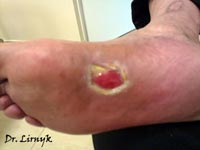

Stage 3 trophic ulcer with underlying arterial insufficiency of the lower limb. Obliterating atherosclerosis. Painful at rest. Term of treatment – two months.
It should be understood that trophic ulcer is not an independent disease but a consequence, complication of this or that disease. Trophic ulcer is a complex of symptoms caused by impaired trophism of tissues (due to inadequate blood inflow or blood outflow, impaired nervous regulation or a host of other causes or their combinations). Trophic ulcer is the top of the iceberg, with its main part hidden.
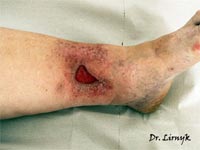
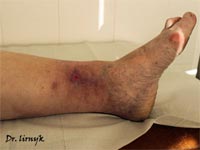
Trophic ulcer. Would not heal for 8 months. Term of treatment – 3 weeks
There exists quite a wealth of trophic ulcers. In the course of my medical practice I have cured a lot of patients with trophic ulcers. And there are ulcers and ulcers. The treatment is always very individualized. One should treat the patient and not the ulcer. Sometimes patient’s cure requires management of several causes, not only one. For instance, the trophic ulcer resulted from varicose disease, followed by diabetes mellitus, osteoporosis, hypertension, fungal skin lesions, microbial eczema, etc. All these problems should be treated comprehensively.
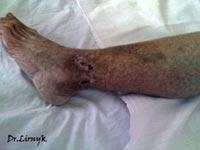

Trophic ulcer. Would not heal for 1,5 years. Term of treatment three weeks. 75 year old female patient.
The patient tries dozens of ointments, visits different specialists, and takes a lot of pills with no result. In despair from treatment failure the patient rushes for help to healers, folk medicine, but there is no result. Even contemporary high technologies do not ensure healing of ulcer. Some patients have trophic ulcers, which are very refractory to treatment. Thus, for instance, even narcotic analgesics do not relieve pain syndrome in patients with Martorell ulcer. Statistical data show high occurrence of suicide among these patients caused by intolerable pain syndrome.
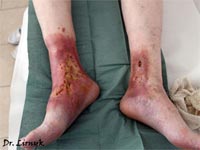
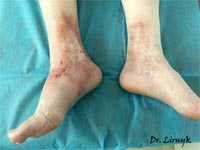
Trophic ulcer. 41 year old female patient. Ulcer would not heal for 15 years. Term of treatment -1,5 month.
Statistics shows that currently venous trophic ulcers occur in 2% of population of developed countries. Namely, in millions of people.
- in almost one in five patients the underlying bone segment is involved in the pathological process with development of ossifying periostitis;
- in 1,6-3,5% of cases lower limbs trophic ulcers are complicated by malignant degeneration;
- in significant number of patients the underlying disease is associated with contracture and ankle joint arthrosis.
- Trophic ulcer is complicated by erysipelas and purulent thrombophlebitis
Some variants of ulceration:
- Trophic ulcer caused by impaired venous blood flow (varicose disease, thrombophlebitis, postthrombotic disease).
- Trophic ulcer caused by impaired arterial blood flow.
- Trophic ulcer caused by impaired lymphatic outflow (lymphostasis, elephantiasis).
- Trophic ulcer caused by impaired tissue innervation (neurotrophic ulcers caused by lesions of nerve roots and nerve trunks).
- Trophic ulcers caused by systemic diseases (hematological, renal, metabolic disorders, vasculitis, collagenoses, etc.)
- Pyogenic (infectious) ulcers due to decreased immunity and resulting from infected microtrauma, folliculitis, furunculosis, pyoderma, purulent eczema and other conditions (including tuberculosis, syphilis, lepra and so on).
- Ulcers caused by influence of physical factors (including radiation).
- Ulcers caused by chemical factors (acids, alkali, solvents, etc).
- Trophic ulcer caused by combination of numerous factors.
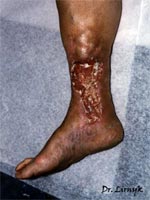
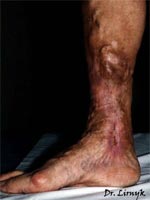
Varicose trophic ulcer. Term of treatment 1,5 month. 65 year old female patient.
Treatment of trophic ulcers
As mentioned above one should treat a patient with trophic ulcer and not the ulcer. Only in this case effect will be achieved. For treatment results of our clinic see the section «TREATMENT OUTCOMES». Cure is what the patient needs the most. And to cure the patient one should use comprehensive approach to him/her and his disease.
Quite a lot of various people were engaged in treating trophic ulcers! Shamans and medicine men treat them, as well as “folk healers” and nuclear physicists and regular people without any knowledge. I have been treating trophic ulcers since 1989. If trophic ulcers would heal so easily, specialists dealing with this problem –vascular surgeons, microsurgeons, dermatologists and the like would be of no need. .
There is no single universal advice for a patient with trophic ulcer, except one – to recover as soon as possible.
To be more specific, in treating hypertensive ulcer one should normalize arterial blood pressure. For this purpose antihypertensive medications selected for each individual patient should be used. In diabetic ulcers, blood glucose should be normalized to improve microcirculation in tissues. In ulcers of arterial etiology there is a need to improve blood flow to the limb, which is achieved by prescription of vascular medications (such as pentoxyphillin, illoprost, alprostan, aspirin) at the stage of conservative treatment. This list could be continued for several pages and the list of drugs would be huge).
Local treatment of trophic ulcer:
In the local treatment of trophic ulcer one should consider various stages of its wound process. In one phase the wound should be moistened, in another one –dried, in the third one –stimulated. In treating ulcer of venous etiology it is crucial to use compression hosiery, elastic bandages.
There exist a whole variety of various medications: ointments, magma, powders. One can find thousands of recommendations on how to cure ulcer in Internet. But in practice they do not help. It becomes clear that if there are very many advice on how to treat something, the problem is not easy to solve. If a certain ointment is good for one patient, it potentially can cause worsening of the condition of another patient. The ointment which helped yesterday can produce bad result tomorrow.
It is very difficult to give specific recommendations, since different ulcers at different stages of their development require different treatment. The best approach is to get treatment under supervision of a specialist.





